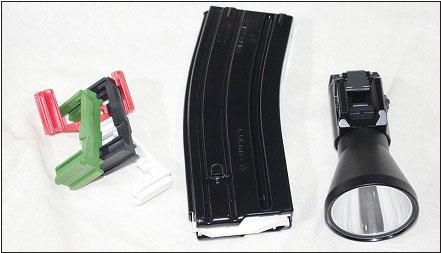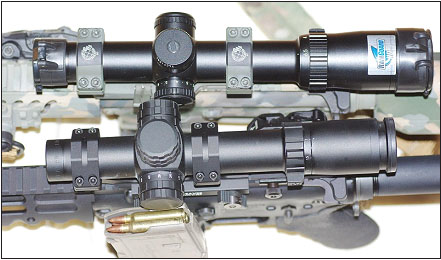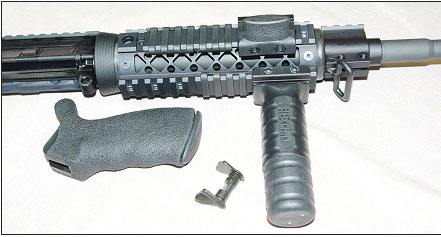
CMC trigger groups which install quickly and easily into an AR series
modern sporting rifle, curved 4.5 lb. (top), flat 3.5 lb. (bottom).
by Scott Smith | Contributing Editor
In the firearms industry, the AR series of rifle is arguably the most popular rifle on the market today. There are many factors that contribute to this; from the number of Veterans who learned to shoot this rifle in the military, the rifle is available in many calibers making it ideal for varmint and big game hunting, and of course the growing popularity of three gun competition has helped. With this growing popularity of the AR, the demand for accessories to personalize your AR has grown exponentially. This past January at the SHOT Show, there were literally rows and rows of these accessories. TheGunMag is going to look at a few of these accessories, to give you an idea of what is on the market today.
One of the great things about the AR series of rifles is that it is a modular firearm. The upper and lower receivers are easily separated for cleaning and maintenance.
This means you can also switch uppers or lowers to change the firearm from a carbine to a pistol caliber carbine to a rifle or heavy barrel varmint rifle or big game rifle depending upon your receiver. With that in mind, this is the first item I will look at, an extra upper receiver.
My Stag Arms 3G Three Gun (515 John Downey Dr, Dept TGM, New Britain, CT 06051; phone: 860-229-9994; online: stagarms. com) rifle is a wicked accurate rifle thanks to its 18” barrel, but there are times a shorter barrel that can accommodate a suppressor would be a good option. To meet that need, I added a Stag 3H upper ($465), which is basically an M4 upper with government profile barrel, 1:9 twist with a Picatinny railed gas block to allow you to mount a flip up front sight to fold it down when using optics. Out of the box, this upper fit the 3G receiver and various other M4s that I have like a glove. Performance-wise, this upper was near match grade, shooting MOA off the bench with most of the loads I used to test it.
The 3H upper while accurate, my shooting partner pointed out, lacked rails to attach a light or laser for duty and home defense. To correct that BLACKHAWK’s Carbine Quad Rail was installed as well as other duty accessories This piece replaces the factory polymer forearm; it takes about five minutes to install it. To protect the rail’s low profile, rail ladder covers ($10.99) were clipped on; to control shots, a vertical grip ($38.99) and thumb rest ($19.99) were added and for comfort on the base M4, an ergonomic grip ($26.99) and an ambidextrous safety ($19.99) were added. These additions make the Stag 3H upper ideal for duty and self-defense applications.

To keep your modern sporting rifle running an E-Lander 30 round
magazine with improved followers and Streamlight’s TLR-1HP.
Having addressed the needs of LEOs, GIs and those who will deploy this upper for personal defense, I needed to adapt it to my needs for Three Gun competition. For this I removed the BLACKHAWK forearm, factory installed gas block and barrel so I could install a rail system and 1:8 twist barrel. Troy Industries’ 151 Capital Dr., Dept. TGM, W. Springfield, MA 01089; phone: 866-788-6412; online: troyind.com) Alpha Rail ($199) was ordered to give me a longer free floated forearm that installed using the factory GI style barrel nut. I chose a 1:8 twist mid-length Criterion barrel ($279.99), low profile gas block ($34.99) and gas tube ($14.49) from Brownells (200 S. Front St, Dept TGM, Montezuma, IA 50171; phone: 800-741-0015; online: brownells.com) ensuring both the 3G and customized 3H would be similar. I removed the A2 flash hider and installed a Surefire (18300 Mt. Baldy Circle, Dept TGM, Fountain Valley, CA 92708; phone: 800-828-8809; online: surefire.com) SOCOM Muzzle Brake ($149), which allows me to mount my Surefire Micro Suppressor. More important for competition use, this brake negates muzzle rise for faster follow-up shots. Installing the longer free floated forearm, barrel and muzzle brake gives you more control when engaging targets, and having like twist barrels allows the end user to shoot the same loads with a fairly high degree of consistency and downrange performance.
While it might seem that these modifications are only useful for action shooting competition, they also make the AR more useful for those who can hunt or shoot precision rifle competitions with them. The free float forearm ensures that the barrel will not make contact when using a bipod. The faster twist rate in the barrel will give you better accuracy at longer ranges with heavier bullets. This ability to use the AR series of rifles for a wide range of use is one of the reasons it has been dubbed the modern sporting rifle.

Stag 3H upper customized using a Troy 13” Alpha Rail w/inserts, Surefire muzzle brake and Criterion barrel ready for Three Gun competition or hunting.
Another item that will make your AR more useful for everything from duty to hunting is a good trigger. While factory “mil-spec” triggers do perform well for their intended use, making the rifle go bang, they hinder accuracy. Mil- spec triggers tend to be gritty and have heavy trigger pulls ranging from 5-8 lbs. There are many aftermarket triggers you can use, but for ease of installation and consistency, I suggest those from CMC Triggers (5597 Oak St, Dept TGM, Ft Worth, TX 76140; phone: 817-562-6611; online: cmctriggers.com). CMC’s triggers are a self-contained drop-in unit that eliminates fighting with the sear spring, proper placement of the hammer spring, and having the sear improperly installed.
CMC offers trigger assemblies with curved or flat triggers so the end user can have a more personalized fit. Both styles of trigger are available in 3.5, 4.5., 5.5 and 6.5 pound options, which again allow for personal or match requirements. I installed a 3.5 lb. model in my competition rifle and 4.5 for my training/self-defense rifle. Many folks will argue you should not change the trigger in any duty/self-defense style weapon, but I would argue it makes the rifle more accurate, hopefully reducing the possibility of missed rounds and the liability attorney attached to them. These trigger assemblies will set you back roughly $160 on average from various retailers. You will find cheaper trigger groups and vastly more expensive ones; however, in my opinion it will be hard to beat CMC Triggers for ease of installation and consistency. Another product that has seen rapid development is optics for the modern sporting rifle. Back when I was a USAF Reserve Security Policeman, about the only option for optics was the 4-power carry handle Colt Scope. Using this scope meant you had to come up with some kind of a cheek riser to give you consistent eye alignment and cheek weld. With the flat top receiver of the M4 series, shooters started mounting their favorite hunting optic. This worked but it was not ideal. Then we started mounting various red dots, which worked great but with aging eyes accuracy at distance started to suffer. Along came the Trijicon ACOG in 3.5 or 4-power and life was good, but not great. Soldiers noticed that at close-quarter battle distances this magnification limited field of view, and neophyte three gun competitors noticed the lack of magnification for those long shots. Then we started to see variable low-power (1.5-4/5) shotgun scopes being used on early modern sporting rifles. Then optics manufacturers started to design optics for this growing market to what we see today: AR specific optics.

o give you a clear view of your target Bushnell’s Tactical Elite 1.5-6 (top)
and Weaver’s Super Slam 1.5-5 (bottom).
Bushnell (9200 Cody, Dept TGM, Overland Park, KS 66214; Phone: 800-423-3537; Online: bushnell.com) and Weaver (1 ATK Way, Dept TGM, Anoka, MN 55303; Phone: 800-379- 1732; Online: weaveroptics.com) are two of the leaders in AR/modern sporting rifle optics. These manufactures have blended variable power optics with red dot sights to give users the best of both worlds. Bushnell’s offering is the Tactical Elite 1.5-6 and Weaver offers the Super Slam series with remain the same throughout the zoom); I have not found point-of- aim/point-of-impact to vary as some folks claim they do. These scopes use tradition capped turrets, which will reduce the chances of knocking off your zero in rough conditions or when traveling in a case.
Weaver’s Super Slam ($1069.95) offers the shooter red/green illumination of the reticle. This is very useful in very lush green areas or the desert southwest where some folks will find a red dot washes out. While Bushnell illuminates only the horseshoe, Weaver illuminates the entire CIRT reticle. I have found this set-up to be easier to find in the bright light of the high deserts of the northern plains and popular for hunting varmints and predators such as coyotes. Many states allow hunting of coyotes and fox at night and for this you need a good light. Streamlight (30 Eagleville Rd., Dept. TGM, Eagleville, PA 19403; online: streamlight.com) offers hunters the TLR-1HP, a 200 lumen output light that is small enough to be carried in a cargo pocket. The TLR- 1HP is a rail mounted light that is operated by the toggle lever; constant on or momentary. With its large focused reflector, you have useable light at distances out to 100 yards. Couple this with good optics and you should be able to thin the local fields of marauding pests.
Another lighting option for your AR is the MVF-515 Grip from Crimson Trace (9780 SW Freeman Dr., Dept TGM, Wilsonville, OR 97070; phone: 800-442-2406; online: crimsontrace.com). The MVF 515 is a light with 150/200 lumen output and laser in a vertical grip to attach to your forearm rail, priced at $479. At first blush this may seem pricey but the light and laser each average a couple of hundred dollars plus the grip. I like the idea of having a compact unit that is designed to function as a unit, not a hodgepodge of gear.
What sets the MVF-515 apart from others is that the controls are ambidextrous. There are also buttons to control the light and laser separately. This might seem like overkill that you do not need, but you may want to use one or the other. I have been using this grip since they were introduced roughly five years ago, and it is still going strong today. I can tell you this is one fine piece of kit.

For duty and personal protection, Stag’s 3H upper is outfitted with BLACKHAWK’s carbine quad rail with ladder rail covers, thumb rest, vertical grip and shown with the ergonomic pistol grip and ambidextrous safety for the lower receiver.
For ease of maintenance of your MVF-515 and to make it easier to break your AR down for cleaning, I suggest having the Range Bag Tool (RBT) ($19.99) and CTC Picatinny Tool ($49.99) from CRKT (18348 SW 126th Place, Dept TGM, Tualatin, OR 97062; phone: 503- 685-5015; online; crkt.com). These tools were designed with Crimson Trace to ensure you have tools to adjust their laser grips; but the tools fit many screws and bolts used on optics for ARs. The RBT is a clip-it tool with a 1.875” partially serrated knife, file, bottle opener, two sizes of flat blade screwdrivers and two hex wrenches—0.028” and 0.050”—for adjusting CTC lasers. The Picatinny tool also includes the small hex wrenches with a pocket clip but with a larger 2¾” knife blade , an 8mm wrench, a scraper, T20 bit, ejector pin punch, and 3/32 hex wrench. With the number of CTC lasers I have seen in use for duty and personal defense these tools will ensure you can adjust your CTC lasers, aid in cleaning your AR and, unlike other tools, not take up a lot of room in your range bag.
The last item we looked at was a magazine. Reliable magazines are the heart and soul of any self-loading firearm.
E-Lander magazines from MAKO (170-20 Central Ave, Dept TGM, Farmingdale, NY 11735; phone: 631-880-3396; online: themakogroup.com) are some of the finest magazines I have used. These are old school steel magazines built in a country that lives by the gun, Israel.

CRKT’s Picatinny tool (left) and Range Bag Tool (right) with Crimson
Trace’s MVF-515 laser/light grip (center).
These magazines use a redesigned follower to ensure consistent feeding in the harshest conditions. The followers ($6.80 for a four pack) of the magazines are offered in black, green, red and white and are sold separately to upgrade other GI magazines. These are anti-tilt followers and reliably engage the bolt catch even when muddy, icy and wet. Thanks to the nasty winter I was able to test them in all these conditions. Thanks to E-Lander’s proprietary coating these magazines are nearly corrosion resistant and because of the lubricity of the magazines they extract/insert easily and smoothly into the mag well. At $18.70 per magazine, they are not cheap but they are designed to take a beating; the Israeli military keeps their M16s and Tavors running with these magazines.
This is but a small sampling of the gear on the market today for the modern sporting rifle, aka the AR rifle. Hopefully we have given you some ideas on ways to upgrade your modern sporting rifle for duty, range, hunting or competition use. Shoot straight, shoot fast, shoot safe and have fun.



